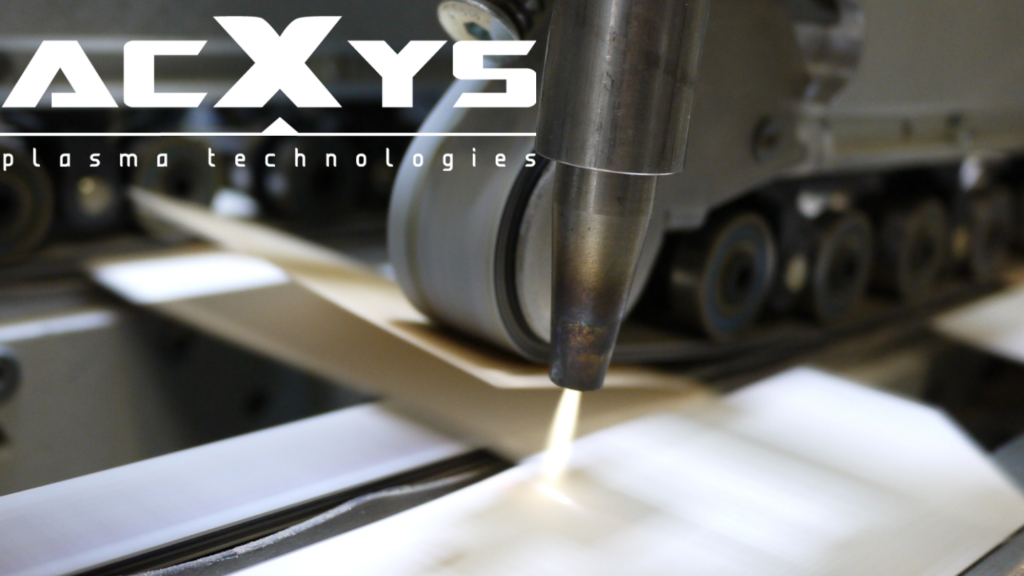Atmospheric Plasma : a formidable technology that solves all the problems of adhesion during cardboard carton manufacturing. Modifying the surfaces of materials such as paper, plastics and varnishes at a molecular level, the plasma improves adhesion to surfaces reputed to be difficult.
Atmospheric plasma for folding-gluing processes
Folding and gluing is an important part of the manufacture of cardboard, paper or plastic packaging. Packaging for food, pharma-ceutical, cosmetic, general consumer goods all need to be folded and glued.
During packaging manufacture the raw material is first printed then cut, folded and glued. The folding-gluing processes are performed at rates of approximately 20 m/min to 400 m/min.
Although the base material of this packaging is cardboard, this is often coated to change its properties. Among the coatings that can be used are PP, PET, PVC. The board can also be varnished or metalised. Wholly plastic packaging is also present in the market.
Adhesion Issues
Compacted cardboard is very easy to glue, due to the condition of its surface. In fact, by looking closely at the structure of the material one notices that it is porous due to the disorderly arrangement of the paper fibres. A liquid such as an adhesive deposited on compacted card-board will, therefore, naturally penetrate the fibres by capillary action.
It will mechanically attach very strongly to the surface. However, the surface of a board that has been coated, varnished, metallised or plasticised is smooth. A liquid in contact with such a surface will, therefore, have difficulty attaching itself mechanically. This behaviour is accentuated by the chemical composition of these materials. The poor energy of a material causes bad adhesion: the glue, as any other liquid, cannot spread and adhere effectively to the surfacée.
In fact, the poor affinity of liquids with plastics, varnishes or metals is due to their low surface energies. In the case of adhesives, the low surface energy causes a very poor adhesion as the glue cannot spread and adhere to the surface. In response to this problem several surface treatment solutions exist.
The first solution is to prevent the areas to be glued from being coated, thereby preserving the raw board properties. This commonly used solution requires special, costly tooling which must be re-adjusted for each packaging specification. The second solution is to mechanically abrade the surface to be glued, usually in a “herring-bone” pattern. This mechanically corrupts the surface structure to improve glue adhesion. A method that requires careful set-up and is not very effective on plastic surfaces. The third solution is to treat each batch of cartons before they are loaded onto the folding-gluing line using corona technology. An expensive solution and very complicated logistically
The Atmospheric Plasma Solution

The use of atmospheric plasma is an alternative solution to adhesion problems. A well-known and trusted technology in the plastics industry, it chemically activates the surface of any material, in ambient conditions, to improve the adhesion of an ink, paint, varnish or even glue. In addition to its extreme effectiveness, plasma’s success is due to its ease of use, its repeatability and its cost.
The principle of the technology is to pass a gas, such as compressed air across an electric arc. The gas then becomes a plasma which is blown directly onto the material to be treated. The energy contained in the plasma causes a chemical reaction which, firstly, eradicates any surface organic residues then, at a molecular level, grafts new properties into it. These new grafted properties are mostly polarised, inducing an increase in surface energy and therefore adhesive adhesion.
Varnished plastics mostly have low surface energy. In the case of plastics this is generally due to the nature of the material but equally to the surface migration of additives used in their manufacture. The dual cleaning and chemical actions of plasma eradicate any surface residues present and equally changes the nature of the surface being treated, thereby modifying the adhesive properties of the material to ensure their intended adhesive qualities.
ULS Omega : safety and ease of integration
With the development of ULS technology by AcXys Technologies, atmospheric plasma becomes the choice solution to folding-gluing problems. Suitable for high speed treatment of small widths (up to 2cm per plasma nozzle), the ULS can prepare the surface of a glue flap in one pass. The ULS module has been specially designed to be very compact for ease of integration.
Multiple nozzles can be used to treat many areas at the same time. These can be integrated in the folding-gluing line in the flap folding zone. As the ULS system treats each carton just before gluing, it is therefore possible to treat all types of carton to enable adhesion without prior surface preparation.








